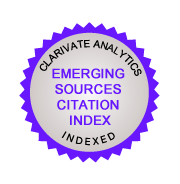Relationship between connectedness with nature and environmental beliefs
DOI:
https://doi.org/10.24310/innoeduca.2019.v5i2.4124Keywords:
Education, Environment, Item Response TheoryAbstract
Connectedness to nature is defined as a feeling of belonging to natural environment. Studies over relationship between connectedness and environmental beliefs from the New Paradigm Environmental Scale, show low-mean correlation values. The aim of this research is to test whether the levels of correlations are by a methodological bias or they are by their structural. An indicental sample of 459 college was involved. At methodological level, we estimated levels of connectedness and beliefs through Item Response Theory. The “ltm” library of R program was used. Then the estimates values were correlated. The results showed low-mean values of relationship between the two variables. This results, together with those from the literature reviewed suggests that the relationship is structural, not by the methodology used. Finally, the educational implications are discussed.
Downloads
Metrics
References
Ajzen, I., y Fishbein, M. (1980). Understanding attitudes and predicting social behavior. Englewood Cliffs, NJ: Prentice-Hall.
Cohen, J. (1988). Statistical power analysis for the behavioral sciences. Hillsdale, New Jersey: Routledge Academic.
Cordano, M., Welcomer, S.A., y Scherer, R.F. (2003). An analysis of the Predictive Validity of the New Ecological Paradigm Scale. The Journal of Environmental Education, 34(3), 22-28.
Dunlap, R. E., Van Liere K. D., Mertig, A. G. y Jones, R. E. (2000). Measuring endorsement of the New Ecological Paradigm: A revised NEP scale. Journal of Social Issues, 56 (3), 425-442.
Dunlap, R.E., y Van Liere, K.D. (1978). The new environmental paradigm. Journal of Environmental Education, 9, 10-19.
Ellis, A., y Bernard, M. E. (2006). Rational emotive behavioral approaches to childhood disorders: theory, practice and research. Birkhäuser: New York.
Festinger, L. (1957). A theory of cognitive dissonance. Stanford, CA: Stanford University Press.
Gosling, E., y Williams, K. J. (2010). Connectedness to nature, place attachment and conservation behaviour: Testing connectedness theory among farmers. Journal of Environmental Psychology, 30(3), 298-304. Doi:10.1016/j.jenvp.2010.01.005
Gardner, G. T., y Stern, P. C. (1996). Environmental problems and human behavior. Boston: Allyn and Bacon.
Matas, A., y Elósegui, E. (en prensa). Características psicométricas de la Escala de Conectividad con la Naturaleza en una muestra universitaria, Psyecology.
Mayer, F.S., y Frantz, C.M. (2004). The connectedness to nature scale: A measure of individuals' feeling in community with nature. Journal of Environmental Psychology, 24, 503-515.
Perrin, J.L., y Benassi, V.A. (2009). The connectedness to nature scale: A measure of emotional connection to nature? Journal of Environmental Psychology, 29, 434-440.
R Development Core Team (2011). R: A language and environment for statistical computing. R Foundation for Statistical Computing, Vienna, Austria. ISBN 3-900051-07-0, URL http://www.R-project.org/.
Rizopoulos, D. (2006). ltm: An R package for latent variables modelin and item reponse theory analysis. Journal of Statistical Software, 17(5), 1-25.
Schultz, P.W. (2001). The structure of environmental concern: Concern for self, other people, and the biosphere. Journal of Experimental Psychology, 21(4), 327-329.
Schultz, P.W. (2002). Inclusion wiht nature: The psychology of human-nature relations. En Schmuck, P., y Schultz, P.W. (Eds.), Psychology of Sustainable Development. Dordrecht: Kluwer Academic Publishers.
Schultz, P.W., Shriver, C., Tabanico, J., y Khazian, A. (2004). Implicit connections with nature. Journal of Environmental Psychology, 24, 31-42.
Vozmediano, L., y San Juan, C. (2005). Escala "Nuevo Paradigma Ecológico": propiedades psicométricas con una muestra española obtenida a través de Internet. Medio Ambiente y Comportamiento Humano, 6(1), 37-49.
Downloads
Published
How to Cite
Issue
Section
License
All contents published by Innoeduca. International Journal of Technology and Educational Innovation are subject to Creative Commons Attribution-Nocomercial-NoDerivatives 4.0 International License, whose complete text can be consulted at https://creativecommons.org/licenses/by-nc-nd/4.0/legalcode. Thus, copying, distribution, public communication, derivative works and commercial use of content are permitted as of the aforementioned issue provided that the source and the author of the text are cited.
It is the responsibility of the authors to obtain the necessary permits for images that are subject to copyright.

This work is licensed under a Creative Commons Attribution-NonCommercial-NoDerivatives 4.0 International License.








1.jpg)



242.png)








